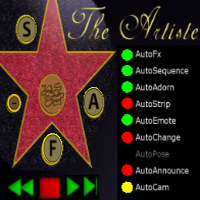Movers and dancer-movement (as opposed to dancer animation) seems to be a very popular addition to SL Dance. Sometimes the curtain opens and you are already in position as a dancer to begin your routine. Other times you may walk, skip, jump, or use another move-affiliated animation to get you from off-stage to on-stage and ready to begin your dance routine. The same often happens at the end of routine where you 'move' one or more dancers from on-stage to off-stage. Multiple dancers can move in unison or independent. They can turn as well as move. They can move in 3 dimensions.
Some forms of dance in RL, the dancers seem to already be in position as in music videos as an example while in ballet you see them prance on and off. Also in dance competitions they stroll on and off.
Movement does add scope and can maximize use of big stage. It often offers perspective, variety, and added interest.
I have attended workshops for some other products and watched how movers are used in many shows. I thought it was time to present the Artiste's version of movers for comparison and analysis. I have demoed and highlighted many Artiste features but have not delved into the Artiste Mover System.
The purpose of this expose is to document as well as inform owners and non-owners.
The system has evolved over time from what I envisioned peoples needs would be to also include what peoples needs actually turned out to be. A couple of key features were created at the request of users actually using the mover system.
I want try a new approach to informing.
Very slow. In byte-sized deliverables.
So this will be presented in multiple parts.
***
Overview
The Artiste Mover System I will refer to as AMS from here on out for convenience sake.
We use an object we call a Palette. It is one-prim, copy/mod. It consists of scripts and notecards.
A Palette can be a lot of different things (abilities), one of which is a 'mover'. You tell it what it can be and do by editing its notecards (ncs).
It can be more than one thing at a time (abilities). (See the State-Of-Shock video as an example of a Palette being a: mover, light, and animated-texture.)
Anything which is mod can be a Palette and as such, can also be a mover.
Unlike some systems, there is no required linking involved to move an object...but you could.
The AMS allows for objects or avatars to be moved.
If all you want to do is move an object, you can prepare it by making the Palette 'movable'. It requires changing one entry in a nc.
Ex:
Moveable,on
Sittable,off
Animatable,off
If you want to move an avatar, then you prepare it by making the Palette moveable, sittable, and animatable. It requires changing three entries in a nc.
Ex:
Moveable,on
Sittable,on
Animatable,on
When a Palette is movable then it can home to an anchor upon reset, reload, or specific chat command. So if you move the anchor then Palettes which are movable will change position (and rotation if need be) relative to the anchor to stay in sync when re-triggered (reset, reload, or specific chat command).
There are a host of other options available but these are the key entries to identify the character of a Palette as a mover.
***
Movers need an anchor. Movers have an entry in a nc that names the anchor it is looking for. The anchor must be owned by you (owner of the Palettes) so there is no conflict with anchors owned by others.
The Artiste Anchor
You can see the Artiste Anchor is just a 1-prim object. It used be just a dumb object with no scripts. Now it has intelligence , a menu and options, but its main purpose is just as a point of reference. (click on it for the menu). You seldom need to use its menu. It does have some nice options of convenience as well as advanced options for when using our bread-crumb-based marker system....a system for movers that most of you are familiar with.
I suggest rezzing the anchor in an accessible place in case you need to access it during a show.
You can can show or hide it from its menu.
***
The Artiste MasterRezzer
(You, of course, do not need to use the MasterRezzer when you are just creating your routine.)
The Artiste MasterRezzer was developed with the SL Performance Dancer in mind. Its main purpose was to simplify the task of set cross-fades and set transitions.
Unique to the Artiste MasterRezzer is that you can:
1) Rez more than 1 set at a time
2) Rez NOCOPY objects
You can also rez NOMOD objects
By adding 1 script and 1 nc to the Anchor, you can make it rezzable, along with anything else you want to rezz. It can be its own set or part of a set. You can have up to 6 sets per MasterRezzer. (A MasterRezzer can also rez another MasteRezzer referred to as Rezzer-Chaining).
You would pack (place) the Anchor inside the MasterRezzer not unlike you do with other rezzers.
You can reset (rehome) your movers using:
1) the Anchor menu or
2) the Artiste Performance HUD Auto-Access menu or
3) the movers (Palettes) menu.
The movers will look for the Anchor and re-position and/or reorient themselves. Movers depend on knowing where the Anchor is in order to perform their moves and turns.
Yes, you can use the Multi-Scene rezzer instead of the Artiste MasterRezzer.
Also, the Artiste MasterRezzer can also be used standalone as it now accepts chat commands.
Ok so now you know about Anchors and how to rez them and how they are used with Movers.
I hope this was not too much or too confusing.
Next up we will begin the process of creating an Avatar Mover.





No comments:
Post a Comment